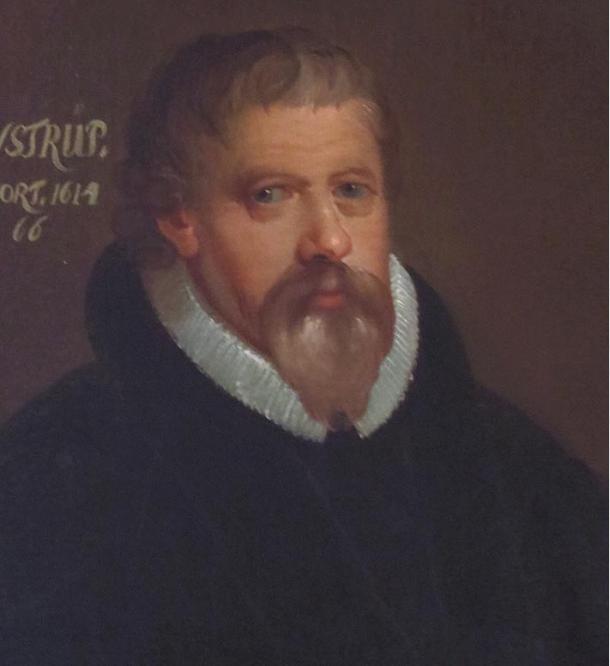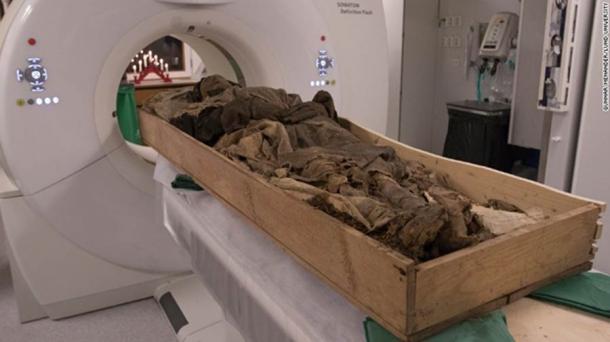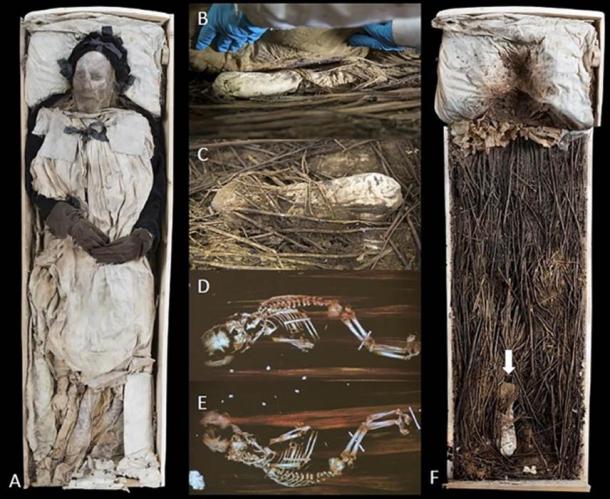Researchers at Lund University hospital were in for a surprise when they conducted a CT scan of a mummified Scandinavian bishop and spotted the remains of a tiny fetus tucked under the bishop’s feet. The mummy belongs to Bishop Peder Winstrup, a prominent historical figure in Scandinavia who died in 1679. For years, archaeologists have been speculating on the reason for the fetus’ placement in Winstrup’s coffin. They’ve finally found the answer.
A new paper in the Journal of Archaeological Science: Reports explains that the discovery of the fetus was made when testing was carried out on Winstrup’s remains in the hope of learning more about the health and lives of people in Scandinavia in the 1600s.
Who was Bishop Winstrup?
“Peder Winstrup, a bishop and prominent historical figure in Scandinavia, was one of the founding fathers of Lund University,” Lund University reported in a press release . “He died in 1679 and was buried in the famous cathedral in Lund a year later. The coffin, together with its contents, constitutes a unique time capsule from the year 1679 with a well-preserved body, textiles and plant material.” Per Karsten, director of the university’s Historical Museum, said:
“We can now observe that Winstrup’s mummy is one of the best-preserved bodies from Europe in the 1600s, with an information potential well in line with that offered by Otzi the ice man or Egyptian mummies. His remains constitute a unique archive of medical history on the living conditions and health of people living in the 1600s.”

Portrait of Peder Jensen Winstrup, 1750. ( Orf3us/CC BY-SA 3.0 )
Lund University reports that Winstrup’s remains had become naturally mummified as a result of “constant air flow, the plant material in the coffin, a long period of illness resulting in the body becoming lean, death and burial during the winter months of December‒January and the general climate and temperature conditions in the cathedral.”
Scanning revealed that Winstrup suffered numerous physical ailments including tuberculosis, pneumonia, atherosclerosis, gallstones, osteoarthritis, and a shoulder injury.
During the scan of Winstrup’s mummified remains, researchers also spotted something highly unusual –a tiny bundle containing the remains of a fetus tucked under the bishop’s feet.

Scanning Bishop Peder Winstrup’s mummified remains. ( Lund University )
The Bishop wasn’t Alone…
“One of the main discoveries when we conducted the CT scanning was that Mr Winstrup is not alone in the coffin. Actually he has a companion – a small child, a 5 to 6-month old fetus,” Karsten said. In 2015 Karsten speculated that the fetus may either be a relation of Winstrup, or may have been an illegitimate child that was placed there by someone unrelated to him, who wanted to sneak the infant remains into his coffin in order to receive a proper burial.
“It has been deliberately concealed under his feet at the bottom of the coffin,” Karsten noted at the time. “Maybe there is a connection between Winstrup and this child, but I think it is more appropriate to think that he has been concealed by some other members of the bishop’s staff when organizing his funeral,” he added.

A. The preserved body of Peder Winstrup in his coffin. B-C. Details of the package containing the remains of the fetus. D-E. CT-scan of the fetus taken at the Lund University Hospital. F. The coffin with removed body of Peder Winstrup and the package containing the fetus visible (by the arrow). Note the (changed) orientation and direction of the straws to the left of package which suggest that it was deposited in the coffin later than Peder Winstrup. (Photo: Gunnar Menander )
Torbjörn Ahlström, professor of historical osteology at Lund University and one of the leading researchers in the study of the fetus, explained just how unusual this action was:
“It was not uncommon for small children to be placed in coffins with adults. The foetus may have been placed in the coffin after the funeral, when it was in a vaulted tomb in Lund Cathedral and therefore accessible. Placing a coffin in a vault is one thing, but placing the foetus in the bishop’s coffin is quite another. It made us wonder if there was any relationship between the child and the bishop.”
Finally Solving the Mystery of the Fetus in the Bishop’s Coffin
Years later, the researchers have now solved the mystery of the fetus in the bishop’s coffin by using DNA from the bishop and the fetus, along with kinship analyses. They believe that the fetus was likely the bishop’s grandson. Their results show that the fetus was a boy sharing roughly 25% of the same genes as the bishop. A difference in mitochondrial lineages but a Y-chromosome match shows that they were related on the father’s side.
“It is possible that the stillborn baby boy was Peder Pedersen Winstrup’s son, and therefore the bishop was his grandfather,” said study co-author Maja Krzewinska of the Center for Paleogenetics at Stockholm University.
In their paper, the researchers detail the family drama revealed by this discovery. They explain that the bishop’s son did not follow in his father’s and grandfather’s footsteps and study theology – he was interested in learning about fortifications instead. In 1680, he lost his father’s property in the Great Reduction and he likely relied on his relatives for financial help for the rest of his life. When Peder Pedersen Winstrup died the male lineage of the Winstrup family also ended.
Top Image: The mummified remains of the 17th-century bishop, Peder Winstrup. Source: YouTube Screengrab / Lund University
Updated on April 8, 2021.
Related posts:
Views: 0
 RSS Feed
RSS Feed
















 April 10th, 2021
April 10th, 2021  Awake Goy
Awake Goy  Posted in
Posted in  Tags:
Tags: 
















